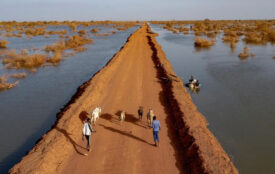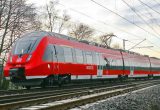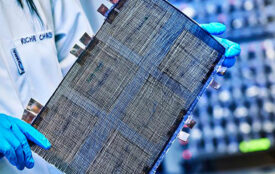Flying using 100 percent sustainable aviation fuel significantly reduces non-carbon-dioxide emissions
Results from the world’s first in-flight study of the impact of using 100 percent sustainable aviation fuel (SAF) on both engines of a commercial aircraft show a reduction in soot particle emissions and formation of contrail ice crystals compared to using conventional Jet A-1 fuel. The ECLIF3 study, in which Airbus, Rolls-Royce, the German Aerospace Center (Deutsches Zentrum für Luft- und Raumfahrt; DLR) and SAF producer Neste collaborated, was the first to measure the impact of 100 percent SAF use on emissions from both engines of an Airbus A350 powered by Rolls-Royce Trent XWB engines and followed by a DLR chase plane. Compared to a reference Jet A-1 fuel, the number of contrail ice crystals per mass of unblended SAF consumed was reduced by 56 percent, which could significantly reduce the climate-warming effect of contrails.
Global climate model simulations conducted by DLR were used to estimate the change in the energy balance in Earth’s atmosphere – also known as radiative forcing – by contrails. The impact of contrails was estimated to be reduced by at least 26 percent with 100 percent SAF use compared to contrails resulting from the Jet A-1 reference fuel used in ECLIF3. These results show that using SAF in flight could significantly reduce the climate impact of aviation in the short term by reducing non-carbon-dioxide effects such as contrails, in addition to reducing carbon dioxide emissions over the lifecycle of SAF.
“The results from the ECLIF3 flight experiments show how the use of 100 percent SAF can help us to significantly reduce the climate-warming effect of contrails, in addition to lowering the carbon footprint of flying – a clear sign of the effectiveness of SAF towards climate-compatible aviation”, said Markus Fischer, DLR Divisional Board Member for Aeronautics.
Mark Bentall, head of Research & Technology Programme, Airbus, said: “We already knew that sustainable aviation fuels could reduce the carbon footprint of aviation. Thanks to ECLIF studies, we now know that SAF can also reduce soot emissions and ice particulate formation that we see as contrails. This is a very encouraging result, based on science, which shows just how crucial sustainable aviation fuels are for decarbonising air transport.”
“SAF is widely recognised as a crucial solution to mitigating the climate impact of the aviation sector, both in the short term as well as the longer term. The results from the ECLIF3 study confirm a significantly lower climate impact when using 100 percent SAF due to the lack of aromatics in Neste’s SAF used, and provide additional scientific data to support the use of SAF at higher concentrations than currently approved 50 percent,” said Alexander Kueper, Vice President Renewable Aviation Business at Neste.
Alan Newby, Rolls-Royce, Director Research & Technology, said: “Using SAF at high blend ratios will form a key part of aviation’s journey to net zero carbon dioxide. Not only did these tests show that our Trent XWB-84 engine can run on 100 percent SAF, but the results also show how additional value can be unlocked from SAF through reducing non-carbon-dioxide climate effects as well.”
The research team has reported its findings in the Copernicus journal Atmospheric Chemistry & Physics (ACP) as part of a peer-reviewed scientific process, and provides the first in-situ evidence of the climate impact mitigation potential of using pure, 100 percent SAF on a commercial aircraft. The ECLIF3 programme, which also includes researchers from the National Research Council of Canada and the University of Manchester, conducted in-flight emissions tests and associated ground tests in 2021.
- Click here to read the full report.








